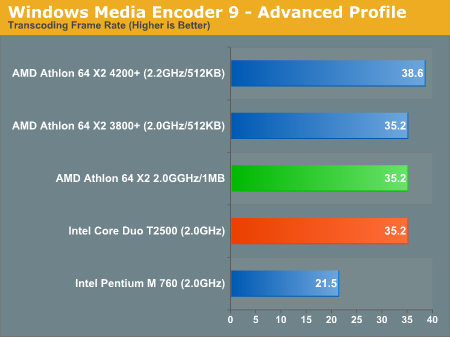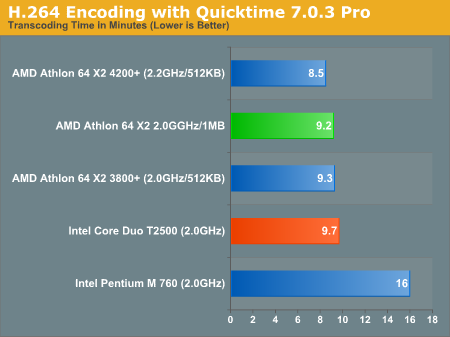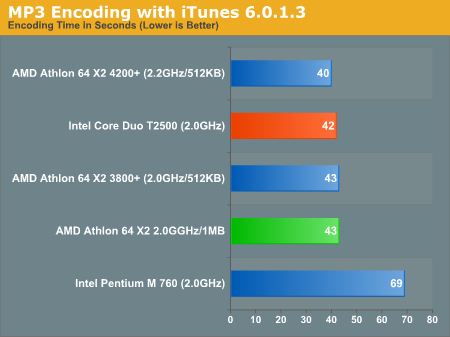Intel Core Duo (Yonah) Performance Preview - Part II
by Anand Lal Shimpi on December 19, 2005 12:55 PM EST- Posted in
- CPUs
Media Encoding Performance with DVD Shrink, WME, Quicktime and iTunes
We were most curious about the Core Duo's media encoding performance, given that a number of the optimizations for the new processor were FP/SSE related. We've updated our entire media encoding test suite, including everything from the one-click DVD ripping utility DVD Shrink to including H.264 encoding performance with Quicktime 7.0.3 Pro. We wanted to include the latest version of DivX in this comparison. However, the recent release of DivX 6.1 left us with a few bugs that we're still trying to work out in our test beds, so we had to exclude it. However, as time goes on, H.264 encoding will quickly become far more important than even looking at DivX, so its omission from this article isn't as big of a loss in terms of forward-looking performance.
First up is DVD Shrink 3.2.0.15. Our test was simple - we took a copy of Star Wars Episode VI and ripped the full DVD to the hard drive without compression, effectively giving us an exact copy of the disc on the hard drive. Then, using the copy of the DVD on the hard drive (to eliminate any DVD drive bottlenecks), we performed a DVD shrink operation to shrink the movie to fit on a single 4.5GB DVD disc. All of the options were left on their defaults, so the test ends up being pretty easy to run and reproduce. The scores reported are DVD encoding times in minutes, with lower numbers meaning better performance.
The DVD Shrink test is quite important as DVD Shrink is quite possibly one of the easiest tools to rip a DVD. The easier a tool is to use, the more likely it's going to be used, and arguably the more important performance using it happens to be.
Moving on, we have our Windows Media Encoder 9 test, which uses the advanced profile settings for video encoding. We left all settings at their defaults and just proceeded with a MPEG-2 to WMV-HD conversion. The values reported are in frames per second, with higher numbers being better.
Next up, we have Quicktime Pro 7.0.3 and we perform a MPEG-2 to H.264 encoding task. All of the settings are left at their defaults, with the exception that we optimize the output file for download with a 256kbps data rate while leaving the resolution untouched. We also adjust the video options to optimize for the best quality. We report the transcoding time in minutes, with lower values being better.
Finally, we have a MP3 encoding test using iTunes 6.0.1.3. For this test, we simply took a 304MB wav file and converted it to a 192kbps MP3 file, measuring the encode time in seconds. The only iTunes option that we changed was to prevent the playback of the song while encoding.
We were most curious about the Core Duo's media encoding performance, given that a number of the optimizations for the new processor were FP/SSE related. We've updated our entire media encoding test suite, including everything from the one-click DVD ripping utility DVD Shrink to including H.264 encoding performance with Quicktime 7.0.3 Pro. We wanted to include the latest version of DivX in this comparison. However, the recent release of DivX 6.1 left us with a few bugs that we're still trying to work out in our test beds, so we had to exclude it. However, as time goes on, H.264 encoding will quickly become far more important than even looking at DivX, so its omission from this article isn't as big of a loss in terms of forward-looking performance.
First up is DVD Shrink 3.2.0.15. Our test was simple - we took a copy of Star Wars Episode VI and ripped the full DVD to the hard drive without compression, effectively giving us an exact copy of the disc on the hard drive. Then, using the copy of the DVD on the hard drive (to eliminate any DVD drive bottlenecks), we performed a DVD shrink operation to shrink the movie to fit on a single 4.5GB DVD disc. All of the options were left on their defaults, so the test ends up being pretty easy to run and reproduce. The scores reported are DVD encoding times in minutes, with lower numbers meaning better performance.
The DVD Shrink test is quite important as DVD Shrink is quite possibly one of the easiest tools to rip a DVD. The easier a tool is to use, the more likely it's going to be used, and arguably the more important performance using it happens to be.

- The Pentium M performs exceptionally poorly, and
- The Core Duo performs exceptionally well.
Moving on, we have our Windows Media Encoder 9 test, which uses the advanced profile settings for video encoding. We left all settings at their defaults and just proceeded with a MPEG-2 to WMV-HD conversion. The values reported are in frames per second, with higher numbers being better.

Next up, we have Quicktime Pro 7.0.3 and we perform a MPEG-2 to H.264 encoding task. All of the settings are left at their defaults, with the exception that we optimize the output file for download with a 256kbps data rate while leaving the resolution untouched. We also adjust the video options to optimize for the best quality. We report the transcoding time in minutes, with lower values being better.

Finally, we have a MP3 encoding test using iTunes 6.0.1.3. For this test, we simply took a 304MB wav file and converted it to a 192kbps MP3 file, measuring the encode time in seconds. The only iTunes option that we changed was to prevent the playback of the song while encoding.

Professional Application Performance with 3dsmax, Adobe Premier and Photoshop
Gaming Performance with Battlefield 2 and Black & White 2










103 Comments
View All Comments
Spoonbender - Monday, December 19, 2005 - link
Am I the only one recalling the old Athlon days?AMD smashes ahead with a great CPU, until around what, 2600+ or so, where they run out of steam, letting Intel overtake them.
Looks like the same might happen again...
Not sure if it's just AMD screwing up, or if it's really a question of resources.
For AMD, Athlon 64 was really a last-ditch gamble. They had to do something big, or they wouldn't exist 5 years from now.
Well, they did, and enjoyed a lot of success, but they might just not have the resources to follow up on it. Instead, their only option might be to milk the A64 for all it's worth, and then take a beating for a year or two, until they're ready with a next-gen architecture
LuxFestinus - Tuesday, December 20, 2005 - link
A question of availability needs to be raised. Are these new duo Intel processors available now? Can anyone say paper launch. How long has the dual Athlon64 been out? I thought so.Griswold - Monday, December 19, 2005 - link
I dont see where you're coming from. The A64 is a K7 on steroids. The P-M is a P3 on steroids and Conroe will also just be a P-M on steroids. Both companies didnt come up with flashy, brandnew architectures over the last few years, they only added flashy things to existing designs. Here and now, it's still Intel playing the catchup game until we see Conroe in stores. And then you always have to keep in mind that AMD is yet to move to 65nm. It will certainly give them some more clockspeed headroom.I agree with the conclusion of the article, we'll see a neck to neck race in a year from now where the better price will make the difference. AMD really doesnt have to flex its muscles now, they can milk the crowd with a superior product - and people will pay whatever to get it, or so it seems.
Calin - Tuesday, December 20, 2005 - link
Several of the flashy brand new architectures of the last few years had any kind of success. Itanium/EPIC, Transmeta, Netburst... As long as Transmeta was supported by a company with very little financial power (so their loss was somewhat expected), Itanium is crawling ahead on life support, and Netburst (while being king of the hill for a good time) will be discontinued.Griswold - Tuesday, December 20, 2005 - link
The point is: Netburst is certainly a design that could be considered newer or more radical compared to the P3->P-M->Yonah/Conroe/Merom route. In the end netburst was still a technical failure, but certainly not a financial mistake.Well and Epic, thats much older than you think. But yes, it never ended up where Intel wanted it to be: on the desktop.
allies - Monday, December 19, 2005 - link
It seems like with Intel's new chips, we're going to be back to a point where neither company has a true lead on the other. AMD is in great position at the moment, but they need to get their Turion X2 out to combat Intel's Centrino Duo. Otherwise, they'll find themselves losing laptop sales, an area which they've come a ways in.Right now, although clockspeed isn't increasing as fast as it once was, is a very exciting time for computer technologies. Parallelism, die shrinking, heat reduction, among other strides are paving the way to the future.
ncage - Monday, December 19, 2005 - link
Are you sure the improvements in games are due to the different Memory Controller technoliges? Are you sure its not the FPU?tfranzese - Monday, December 19, 2005 - link
I was thinking the same, considering his thoughts are pure speculation on his part. So, until Anand can provide data to back that up, he should stick to commending AMD's architecture rather than trying to credit all their success to the on-die memory controller (which surely helps, but it's only one part in the formula).I would doubt AMD is sitting idle though, and as they work on their next architecture will keep their lips sealed in order to maintain an element of surprise. Surprise like when they added SSE support to the Palomino and SSE3 support to Venice - both unexpected additions.
Furen - Monday, December 19, 2005 - link
The K8s execution core is pretty much the same as the K7s. If you compare performance (in games) between the two you'll notice that the K8 performs much better. This is due to the fact that it removes the FSB bottleneck (by integrating the memory controller), increases the width of the L2 cache (and the size) and dramatically drops the memory access latency. Sure there are other minor differences but they're mostly minor improvements, like better branch prediction, etc.tfranzese - Monday, December 19, 2005 - link
I don't see where the two of you are going with this and only serve my point that pinning the successes of the architecture on the memory controller is only speculation.